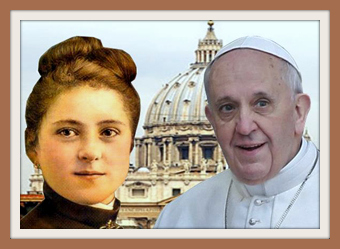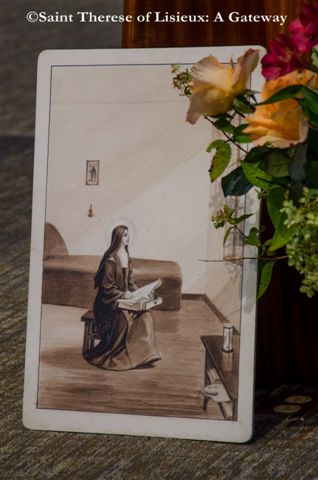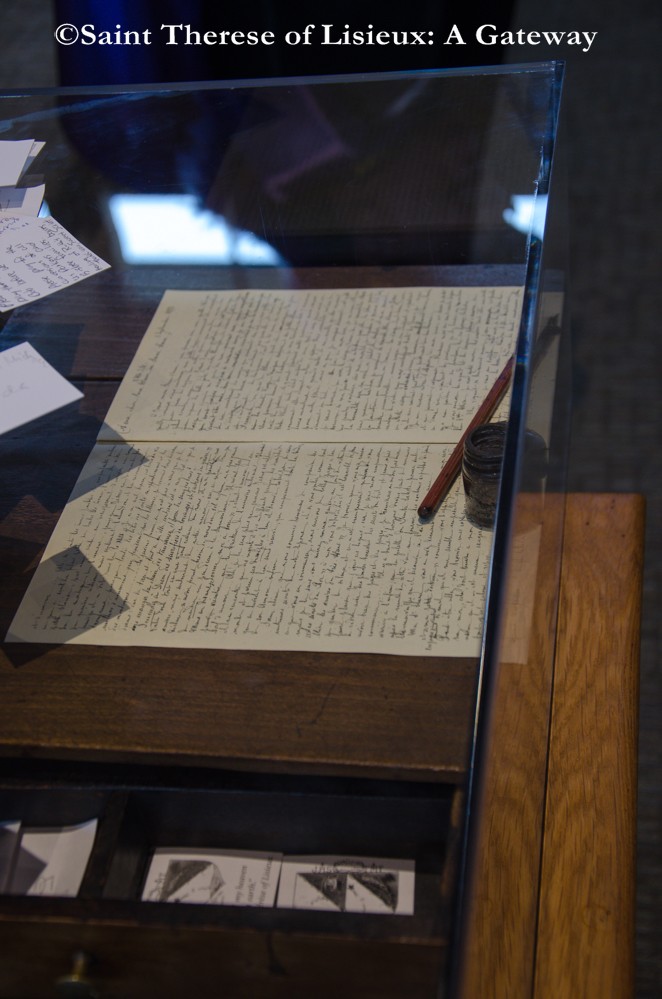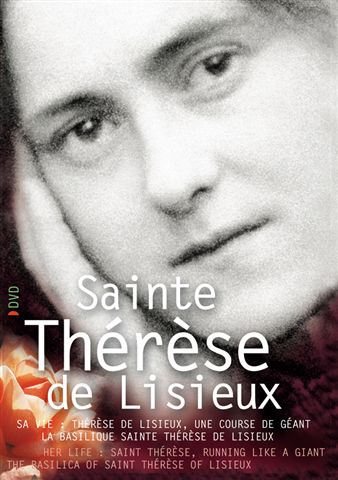Saint Therese of the Child Jesus
of the Holy Face
Entries by Maureen O'Riordan (555)
St. Therese sent a white rose to Pope Francis on September 8, 2013. Why that date?

On September 26, 2013, the Vatican Insider reported that on Sunday, September 8, 2013, the day after the prayer vigil for peace in the world, Pope Francis received a rose from St. Therese of Lisieux. The Pope authorized the Archbishop of Ancona and Osimo, Edoardo Menichelli, to disclose this news at a press conference in Pedaso, in the region of Marche, Italy, at which Archbishop Menichelli presented a book by theologian and writer Gianni Gennari entitled Teresa di Lisieux. Il fascino della santità. I segreti di una dottrina ritrovata (Thérèse of Lisieux. The fascination of sainthood. Secrets of a rediscovered doctrine) and published by Lindau. We now know that this was the book Pope Francis took with him when he flew to Brazil last July.
As the Pope was walking through the Vatican gardens, a worker presented him with a white rose. Archbishop Menichelli said:
“The Pope told me he received the freshly-picked white rose out of the blue from a gardener as he was taking a stroll in the Vatican Gardens on Sunday 8 September. The Pope sees this flower as a “sign”, a “message” from Saint Thérèse of Lisieux, whom he had turned to in a moment of worry the day before.”
At the prayer vigil for peace the evening before, the joyful mysteries of the rosary were recited, and, after each decade, a stanza of Therese's poem "Why I Love You, O Mary" (related to the joyful mystery that had just been prayed) was read. In Vatican Insider Andrea Tornielli notes that the Pope did not tell the Archbishop that the white rose had any connection to the prayer vigil for peace in Syria, but, of course, the international situation must have been a great anxiety on the day of the prayer vigil.
The white rose was linked to Pope Francis while he was still Cardinal Bergoglio. In the book, Pope Francis: Conversations with Jorge Bergoglio: His Life in His Own Words by Sergio Rubin and Francesca Ambrogetti (originally published in 2010 under the title "El Jesuita" ("The Jesuit") and now available in English), then-Cardinal Bergoglio revealed that St. Therese of Lisieux was his favorite saint and that he turns to her in time of need. He kept a photo of her on his library shelf with a vase of white roses in front of it. "When I have a problem I ask the saint, not to solve it, but to take it in her hands and help me accept it; almost always, I receive a rose as sign." See more about Pope Francis, St. Therese, and the rose.
Although the famous line "After my death I will let fall a shower of roses" has been widely publicized in connection with St. Therese, so that most people see the rose as a sign of the favors she has obtained for humanity from God, in Therese's lifetime she identified herself with the rose and longed to be "unpetalled" to give glory to God. See more about this symbolism, read Therese's poem "The unpetalled rose," and listen to a recording of her cousin, Jeanne Guerin, singing the poem in French.
Why did St. Therese send this rose to Pope Francis on September 8?
Of course, St. Therese wanted to console the Pope as he and the world were praying for peace. On September 8, 1890, she wrote in her "Profession letter," which she carried over her heart as she made her vows:
"May the things of earth never be able to trouble my soul, and may nothing disturb my peace. Jesus, I ask You for nothing but peace, and also love, infinite love without any limits other than Yourself, love which is no longer I but You, my Jesus."
(The Prayers of Saint Therese of Lisieux, tr. Aletheia Kane, O.C.D. Washington, D.C.: Washington Province of Discalced Carmelites, 1996, p. 38).
But the choice of the date September 8, which was a day of unique graces for Therese, may have a deeper personal significance for St. Therese's relationship with Pope Francis himself. First, September 8 is the feast of the Birth of Mary and the date of Therese's profession of vows in 1890. (See a story with photos here).
Fr. Adolphe Roulland, MEP. Photo: Paris Foreign Missions Society
Second, in 1896 Therese learned for the first time of a great grace she received on that date. On November 1, 1896 she wrote to her spiritual brother, the newly ordained priest Father Adolphe Roulland of the Foreign Missions Society in Paris, then serving as a missionary in China:
Allow me to confide a secret to you that was just revealed to me by the sheet of paper on which are written the memorable dates of your life.
On September 8, 1890, your missionary vocation was saved by Mary, Queen of Apostles and Martyrs; on that same day, a little Carmelite became the spouse of the King of heaven. Bidding an everlasting adieu to the world, she had one goal, to save souls, especially the souls of apostles. From Jesus, her divine Spouse, she asked particularly for an apostolic soul; unable to be a priest, she wanted that in her place a priest may receive the graces of the Lord, that he have the same aspirations, the same desires as herself . . . .
Brother, you know the unworthy Carmelite who offered this prayer. Do you not think, as I do, that our union confirmed on the day of your priestly ordination began on September 8? . . . I believed I would meet only in heaven the apostle, the brother whom I had asked from Jesus; but this Beloved Saviour, raising a little the mysterious veil that hides the secrets of eternity, has seen fit to give me in this exile the consolation of knowing the brother of my soul, of working with him for the salvation of poor infidels.
Oh! how great is my gratitude when I consider the kind attention of Jesus!. . . What is He reserving for us in heaven if here below His love dispenses surprises so delightful?
More than ever, I understand that the smallest events of our life are conducted by God; He is the One who makes us desire and who grants our desires . . . .
Letters of St. Therese of Lisieux, Volume II, 1890-1897, tr. John Clarke, O.C.D. (Washington, D.C.: Washington Province of Discalced Carmelites, 1988), pp. 1014-1015.
Therese writes of Mary's having "saved" the missionary vocation of Adolphe Roulland. She is referring to a pilgrimage he made to the shrine of Notre Dame de la Delivrande (in English, "Our Lady of Ransom" or "Our Lady of Perpetual Help") in Douvres la Delivrande, Normandy (about an hour's drive from Lisieux) on September 8, 1890. At the Apostolic Process Father Roulland testified:
"On September 8, 1890, I was having some hesitancy concerning my vocation and entrance into the Major Seminary. While I was praying in the chapel of Our Lady of Ransom, I suddenly and definitively came to a decision. I learned later that on the same September 8, 1890, the day of the Servant of God’s Profession, she had asked Our Lord to give her the soul of a priest, and she pointed out the link between these two events.”
Apostolic Process, p. 2903, cited in Letters of St. Therese of Lisieux, Volume II, p. 1019, footnote 3.
Therese was always attuned to dates as a sign of grace. She had sent Father Roulland the "days of grace" in her life and had asked him to send her the memorable dates of his life, that she might be particularly united to him in prayer and thanksgiving on those anniversaries. With his letter of September 25-26, 1896, he sent the list, including "Vocation saved by Our Lady of Perpetual Help: September 8, 1890." It's in response to this list of dates that Therese, on November 1, 1896, wrote the letter quoted above.
Father Roulland died in 1934, nine years after his "little sister" was canonized. Now that his mission on earth is complete, might St. Therese have asked God to choose Pope Francis as the priest who now "in her place may receive the graces of the Lord, that he have the same aspirations, the same desires as herself . . . .?" Does she now call Pope Francis "the brother of my soul?"
Archdiocese of Kansas City in Kansas to receive the writing-desk of St. Therese for veneration on October 8, 2013
The Archdiocese of Kansas City in Kansas has announced that the little writing-desk of St. Therese of Lisieux will visit the Church of the Nativity in Leawood, Kansas for public veneration on Tuesday, October 8, 2013. Veneration will begin at 3 p.m. and close at 7 p.m. A closing prayer service will begin at 7:00 p.m. There will also be veneration only for elementary and high school children on October 8.
FAQ about the writing-desk of St. Therese of Lisieux
 Photo credit: William Hoffmann.
Photo credit: William Hoffmann.
Click on the image to read Frequently Asked Questions about the writing-desk and about St. Therese's writing, including:
- What did Therese sometimes keep in her writing-desk that her novice mistress was not supposed to see?
- Why did Therese once spit into her inkwell?
- Whose photograph did Therese keep hidden in her writing-desk?
The "inside story" of the two writing-desks St. Therese used during her lifetime
 Photo credit: William Hoffmann
Photo credit: William Hoffmann
Click on the image to learn when Therese got her first writing-desk, why she stopped using it, to whom she gave it, where she found a replacement, and much more. See the last lines she ever wrote with the writing-desk that is on tour.
The documentary "Saint Therese of Lisieux: Running Like A Giant" with English audio
"Saint Therese of Lisieux:
Running Like A Giant."
In this unique 35-minute documentary, Fabrice Maze recounts the 24 years of the earthly life and the extraordinary posthumous life of St. Therese of Lisieux. We share in the footsteps of her family, the places of her childhood and adolescence, as well as in the daily milestones of her religious life. Produced by the Shrine at Lisieux, Office Central de Lisieux, and Seven Doc, this documentary was actually filmed in Therese's two family homes, her parish church, and her Carmel, with photographs from that time. The scenes of Therese's life are filmed in the rooms where they happened, with the very artefacts from that time.
"Saint Therese of Lisieux: Running Like a Giant" is a superb introduction to St. Therese and a splendid resource for individuals and groups. The film is a wonderful background for reading Therese's memoir, Story of a Soul.
The same DVD also contains a second film, The Basilica of Saint Therese of Lisieux, in which we discover the biggest religious building constructed in France in the 20th century, a symbol of the worldwide radiance of Therese. Bonus videos about the making of both films.
You may order this film online from Seven Doc, a company in France which produces splendid documentaries about spirituality and other topics. An international film, this DVD is universal ("all regions"), and, when you play it, you can choose English or French audio. In the version with French audio, you may select subtitles in German, Spanish, Italian, Polish, and Portuguese. I recommend it highly.
For more information or to order, click on the image above or click here. See the two-minute trailer.
